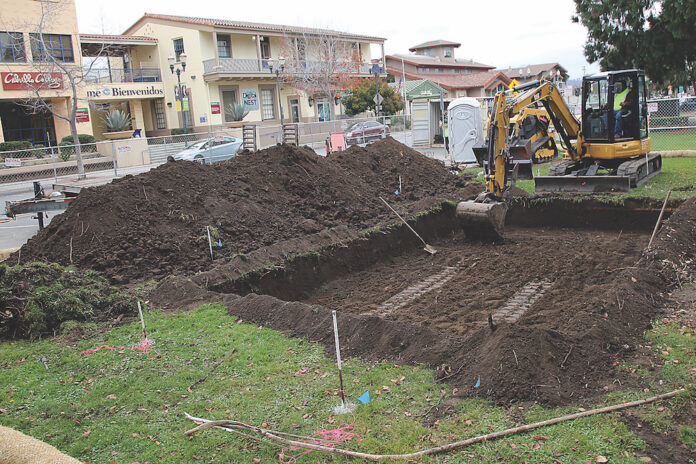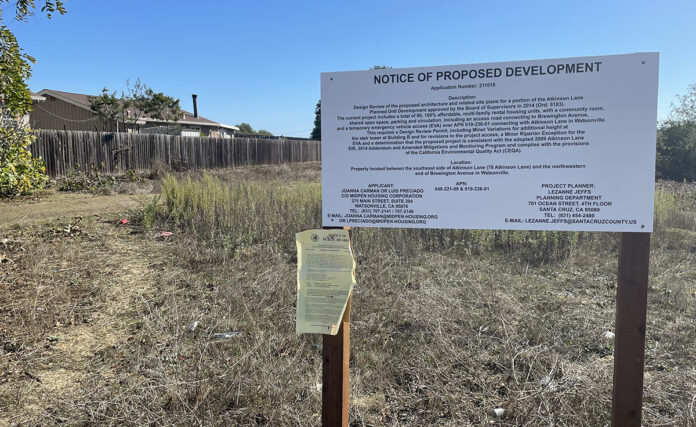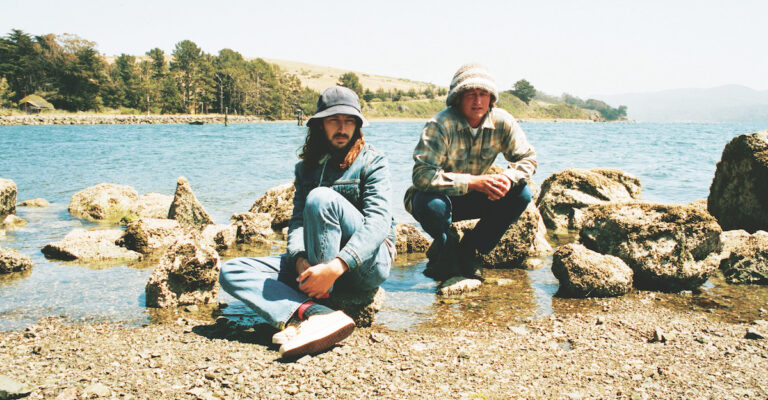A weekly guide to what’s happening.
ARTS AND MUSIC
AN EVENING WITH BRUCE COCKBURN 50TH ANNIVERSARY CONCERT! Bruce Cockburn celebrates 50 years in music with his 50th Anniversary Concert Tour and a stop in Santa Cruz! Come celebrate this achievement with us on December 8th at the Rio Theatre. Tickets available at pulseproductions.net. Come celebrate Bruce’s 50 years in music with us. Wednesday, Dec. 8, 8pm. Rio Theatre, 1205 Soquel Ave., Santa Cruz.
BYRON WESTBROOK & ALEX PELLY & VOLVO 240DL LA-based artists Byron Westbrook and Alex Pelly present a live audio/visual collaboration using electronics and modular video synth. The project expands from their online performance created earlier this year for the cathartic and damaged compositions on Distortion Hue, Westbrook’s recent LP with Hands in the Dark. This live iteration features Pelly’s colorful and dynamic audio-reactive images activated by Westbrook’s sonics made with analog and digital synthesizer, computer and processed cassette tape. Volvo 240DL is a collaborative project between multidisciplinary artist and maker, Grace Cofrancesco and composer and artist Albert Peacock. The duo was born out of a shared desire for cathartic expression that culminated in an impromptu performance between the artists at a local gallery show in Santa Cruz. Since, they have come together to explore what years of anxious energy has inspired in their individual artistic ventures, as a pair. Their performances examine, deconstruct and recreate narratives of decay, destruction, piety and pain through absurdism, humor and often a litany of repeating images and sounds. Friday, Dec. 10, 8pm. Indexical, 1050 River St #119, Santa Cruz.
CELTIC TEEN BAND PROGRAM Teenage musicians ages 12-19 play in an ensemble, developing musicianship, flexibility, and musical creativity. Participants work on music from Ireland, Scotland, Brittany, Norway, Sweden and the United States, in addition to modern and more quirky pieces. Instruments welcomed include fiddle, viola, flute, tin whistle, pipes, cello, upright bass, guitar, mandolin, banjo, dulcimer, autoharp, ukulele, Celtic harp, accordion and percussion. Students must have at least two years of experience on their instrument and must be able to read sheet music and chord symbols. The group meets twice a month Wednesday afternoons from 3:30-5pm at the London Nelson Center with fiddle teacher John Weed. Cost is free-$10 per session on a sliding scale. Potential students are welcome to come for a session and see if they like it—no obligation! More information and registration at CommunityMusicSchool.org/teenband. Wednesday, Dec. 8, 3:30pm. London Nelson Community Center, 301 Center St., Santa Cruz.
LET’S TALK ABOUT THE MOVIES Film buffs are invited to join us online every Wednesday night at 7pm. to discuss a currently streaming movie. For more info, please visit our webpage: https://groups.google.com/group/LTATM.
PUMP BOYS AND DINETTES Filled with an exuberant mixture of country/pop/rock and musical theatre tunes, Pump Boys is a slice-of-life show about some down-home folks who run the local gas station and diner in a rural southern town. This cast of characters and their straightforward take on life, love and music will leave you tapping your foot and smiling from ear to ear. Thursday, Dec. 9, 7:30pm. Friday, Dec. 10, 8pm. Saturday, Dec. 11, 2pm, 8pm. Sunday, Dec. 12, 2pm. The Colligan Theater, 1010 River St., Santa Cruz.
COMMUNITY
COMMUNITY PILATES MAT CLASS Come build strength with us. This very popular in-person community Pilates Mat Class in the big auditorium at Temple Beth El in Aptos is in session once again. Please bring your own mat, small Pilates ball and theraband if you have one. You must be vaccinated for this indoor class. Suggested donation of $10/class. Thursday, Dec. 9, 10am. Tuesday, Dec. 14, 10am. Temple Beth El, 3055 Porter Gulch Road, Aptos.
CUÉNTAME UN CUENTO Acompáñanos para una hora de cuentos, actividades y canciones en español. Este programa es para niños de 0-8 y sus familias. La hora será miércoles a las 4:30pm. Nos reuniremos en el porche exterior. Cuéntame un Cuento se llevará a cabo en Capitola durante el período de construcción de Live Oak. En caso de mal clima, se cancelará la hora de cuentos. Join us for Spanish Storytime, activities, and music! This program is best suited for kids ages 0-8 and their families. Storytime takes place on Wednesday at 4:30pm. We will meet on the outside porch. Storytime will take place at Capitola during Live Oak’s construction period. In the event of bad weather, storytime will be cancelled. Wednesday, Dec. 8, 4:30pm. Capitola Library A Santa Cruz City County Public Library Branch, 2005 Wharf Road, Capitola.
DOWNTOWN SANTA CRUZ ANTIQUE FAIRE The Santa Cruz Antique Faire is on the second Sunday of every month from 8am-5pm. Vendors offer an eclectic blend of antiques and unique items, vintage clothing, collectibles, LPs, clothing, furniture, memorabilia, home decor and more! Sunday, Dec. 12, 9am-5pm. Downtown Santa Cruz Antique Faire, Lincoln St. between Pacific and Cedar, Santa Cruz.
FARLEY’S CHRISTMAS WONDERLAND From Saturday, November 27 to Friday, December 31 (except when it’s raining), Farley’s Christmas Wonderland will be open. A walk-in Christmas display located in the midtown of Santa Cruz, this exhibit is very traditional: lots of Christmas trees, garlands, sleighs, an elf village, a miniature village, and a log cabin that Santa uses for his rest stops. There is also a fairy grotto with two waterfalls and fairies that can be viewed on special nights. Also, on those special nights, it even snows! Donations are welcome. 108 Seaview Ave., Santa Cruz. farleys-christmas-wonderland.com.
GREY BEARS BROWN BAG LINE Grey Bears are looking for help with their brown bag production line on Thursday and Friday mornings. Volunteers will receive breakfast and a bag of food if wanted. Be at the warehouse with a mask and gloves at 7am. Call ahead for more information: 831-479-1055, greybears.org. Thursday, Dec. 9, 7am. California Grey Bears, 2710 Chanticleer Ave., Santa Cruz.
HOLIDAY LIGHTS TRAIN A seasonal tradition returns to Santa Cruz with the Santa Cruz Holiday Lights Train. Vintage excursion cars, adorned with thousands of colorful lights, roll through city streets past homes of Santa Cruz. First-class private coach cars can also be reserved for groups up to 50 people. Availability is limited so book in advance. Roaring Camp Railroads, 5401 Graham Hill Road, Felton. Runs through Dec. 23. Schedule and tickets at roaringcamp.com.
HOLIDAY LIGHTS 2021 The Santa Cruz County Fairgrounds Foundation and the Agricultural History Project presents Holiday Lights 2021 at the Santa Cruz County Fairgrounds. Holiday Lights is a half-mile drive-through experience at the fairgrounds of spectacular lighted holiday displays. See giant Christmas trees twinkling with lights, Santa, reindeer, snowmen, lighted tunnels and more. New this year are two evenings of walk-through holiday lights on Friday, Dec. 3 and Saturday, Dec. 4 in conjunction with the Heritage Holiday Craft and Gift Fair. Tickets will only be available at the gate for these two evenings, and ticket gets you admission to Holiday Fair Shopping, too. For drive-through tickets (Thursday, Friday, Sunday), go eventbrite.com/e/holiday-lights-tickets.
VEGAN ARTISAN CHOCOLATE AND WINE PAIRING CLASS Greetings Chocolate & Wine Lovers! Join me for a delightful afternoon celebrating the holiday season and enjoying the beautiful art of Vegan Artisan Chocolate Making and Wine Pairing at the lovely FlipJack Ranch in Bonny Doon nestled in the magical Santa Cruz Mountains! In this delicious and fun vegan artisan chocolate and wine pairing class; you’ll make exquisite chocolate arts with Valrhona France Manjari 64 percent Dark Chocolate and incredible selections of organic ingredients such as herbs, flowers, chocolate covered cacao nibs, freeze dried raspberries, candied orange, dried fruits, nuts and fleur de sel. I will provide a name badge and an apron for each student, a delicious Provence lavender-infused French roast coffee, a tantalizing fruity red rooibos tea and a decadent Chocolate Persimmon Lavender Tart before the start of class and gourmet vegan tapas throughout the class. It’s an experience you’ll savor from beginning to end. This delicious class makes a beautiful gift to yourself and your loved ones for birthdays and anniversaries too! Please note: As a safety precaution for everyone, all registered students in my culinary and wine pairing classes must be fully vaccinated. Saturday, Dec. 11, 1-5pm. Flipjack Ranch, 4600 Smith Grade, Santa Cruz.
WEST CLIFF HOLIDAY OUTDOOR MARKET 2021 Come enjoy our holiday outdoor market with unique artisans and food trucks while taking in the spectacular view of the ocean. This one of a kind market will be held in two parking lots along West Cliff Drive in Santa Cruz. This is always a popular spot for locals and tourists, as it overlooks the famous Steamers Lane surf spot. The market will feature handcrafted gifts and a chance to do some holiday shopping before the rush. There will also be live music and admission is free. We will also be giving away free tokens every hour to random shoppers. The tokens can be used towards any vendor of your choice. So come down and get your free gift! See you on the cliffs! Saturday, Dec. 11, 10am-4pm. Lighthouse Point Park, West Cliff Drive, Santa Cruz.
COMPASSIONATE FRIENDS OF SANTA CRUZ As of Fall 2021, all meetings are still online. Please see our website for current info and to join our email list for meeting links. Parents of a child who died at any age, from any cause, any length of time ago, are invited to join The Compassionate Friends of Santa Cruz for our monthly grief support meeting. Opening circle followed by smaller connection groups. Sharing is optional. Grief materials available. Bereaved grandparents and adult siblings are also welcome. Non-religious. Monday, Dec. 13, 7-8:30pm.
ANTIRACIST PSYCHOTHERAPY WORKSHOP Join renowned author David Archer for a workshop focused on the topic of antiracist psychotherapy. For care providers of all types, you will receive interactive training on how racial trauma influences us in our work with clients, and for all community members, you will receive fresh information on how we can shift the narrative on race and racism which impacts all of us. This is a virtual event, for more information visit bookshopsantacruz.com/david-archer. Friday, Dec. 10, 9am.
ENTRE NOSOTRAS GRUPO DE APOYO Entre Nosotras support group for Spanish speaking women with a cancer diagnosis. Meets twice monthly. Registration required, please call Entre Nosotras 831-761-3973. Friday, Dec. 10, 6pm. WomenCARE, 2901 Park Ave., Suite A1, Soquel.
S+LAA MENS’ MEETING Having trouble with compulsive sexual or emotional behavior? Recovery is possible. Our small 12-step group meets Saturday evenings. Enter through the front entrance, go straight down the hallway to the last door on the right. Thursday, Dec. 9, 6pm. Sutter Maternity & Surgery Center, 2900 Chanticleer Ave., Santa Cruz.
WOMENCARE ARM-IN-ARM WomenCARE Arm-in-Arm Cancer support group for women with advanced, recurrent, or metastatic cancer. Meets every Monday, currently on Zoom. Registration is required, call WomenCARE at 831-457-2273. All services are free. For more information visit womencaresantacruz.org. Monday, Dec. 13, 12:30pm.
WOMENCARE TUESDAY SUPPORT GROUP WomenCARE Tuesday Cancer support group for women newly diagnosed and through their treatment. Meets every Tuesday currently on Zoom. Registration required, call WomenCARE 831-457-2273. Tuesday, Dec. 14, 12:30-2pm.
WOMENCARE WRITING CIRCLE Writing Circle for women with a cancer diagnosis. Meets on the 2nd Saturday every other month from 10:00 AM – 1:00 PM. Registration Required: WomenCARE (831) 457-2273. Saturday, Dec. 11, 10am-1pm. WomenCARE, 2901 Park Ave., Suite A1, Soquel.
WOMENCARE: LAUGHTER YOGA Laughter yoga for women with a cancer diagnosis. Meets every Wednesday, currently via Zoom. Registration is required, please call WomenCARE at 831-457-2273. Wednesday, Dec. 8, 3:30-4:30pm.
OUTDOOR
HISTORIC RANCH GROUND TOUR Discover what life was like a century ago on this innovative dairy ranch. This hour-long tour includes the 1896 water-powered machine shop, barns and other historic buildings. The vehicle day-use fee is $10. For more information, call 831-426-0505. Spaces are limited and early pre-registration is recommended. Attendees are required to self-screen for Covid-19 symptoms when pre-registering. Masks and social distancing are also required at all programs. Saturday, Dec. 11, 1-2pm. Sunday, Dec. 12, 1-2pm. Wilder Ranch State Park, 1401 Coast Road, Santa Cruz.



















